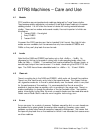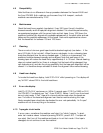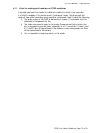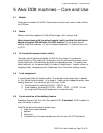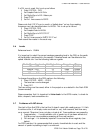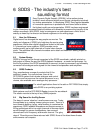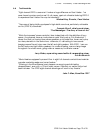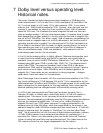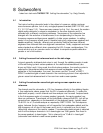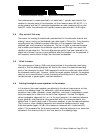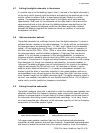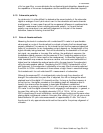
8 Subwoofer s
SDDS Print Master Guidelines, Page 22 of 26
40
63
100
160
250
400
630
1K
1.6K
2.5K
4K
6.3K
10K
16K
Center channel loudspeaker response
40
63
100
160
250
400
630
1K
1.6K
2.5K
4K
6.3K
10K
16K
Digital subwoofer (LFE) channel response
10dB higher SPL
T he meas ur ement is made acous ti cally, not electrically. T ypically, each band of the
analyser in the pass band of the s ubwoofer will then measure about 80 dB SPL. If a
screen speaker and the L FE subwoofer loudspeaker are each measured wi th a wide
band SPL meter, the s ubwoofer will typically measure appr ox i matel y 5.5 dB higher.
8.4
W hy we do it this way.
T he r eas on for lowering the electr i cally recorded l evel of the s ubwoofer channel and
making i t up by turning up the pl ayback gain dates back to 70mm film. T he s ubwoofer
recording l evel was lowered to pr event saturation of the magneti c t r ack and the
playback gain was increased to compens ate. The loss of signal to nois e per for mance
was inconspicuous because the s ubwoofer signal was sent through a l ow pass filter
and did not reproduce hi ss. This level difference convention has been retained in the
digital world, where i t serves to give addi ti onal effective headr oom for the pl ayback of
low fr equency sound effects through the s ubwoofer loudspeaker.
8.5
W hat it means.
T he cons equence of having 10dB more acoustical gain in the s ubwoofer monitoring
channel is that the dubbing engineer will tend to turn down the electrical recording
level of the s ubwoofer by about 10dB compared to what she woul d have done wi thout
the i ncr eas ed moni tor gain. However, unlike the s cr een speaker channels, the engi neer
does not use a cons ol e meter to check the el ectr i cal recording l evel of the s ubwoofer
(except perhaps to guar d agai ns t overload condi ti ons ).
8.6
Setting t he digit al screen speakers in the cinema.
In the cinema, the s cr een speakers are adj us ted i n the almos t same manner as they
were on the dubbi ng s tage. This calibration, which encompasses the ci nema
processor’s main fader, equalizers, power amplifiers, crossovers, loudspeakers, screen,
and r oom respons e, is referred to as the B- chain alignment. Consider the di gitally
driven loudspeaker alignment first, as it is the mos t important. An electrical reference
signal, generally wide band pi nk noise gener ated wi thi n the ci nema pr ocessor at a
specific l evel , is used to align each of the s cr een speakers to gi ve the des i r ed r es pons e
(the X- cur ve or other reference r es pons e) and acoustical reference level for each
individual speaker (again, 85 dBc, slow r es pons e, measured wi th a wi de- band S PL
meter). This procedure ties the ci nema pr ocessor’s electrical reference to an acoustical
reference in the cinema, similar to what was done on the dubbi ng s tage.



